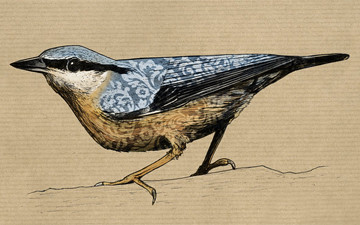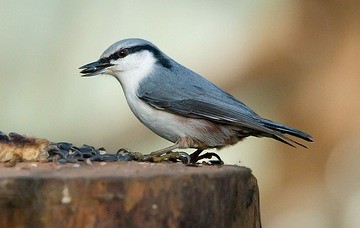The Eurasian Nuthatch, Sitta europaea, is a small passerine found throughout temperate Europe and Asia, although not in Ireland. It belongs to the nuthatch family Sittidae.
This bird is the most common and most widespread nuthatch, and is often referred to just as the Nuthatch.
It is a resident bird of deciduous woods and parkland, with some old trees for nesting. It feeds on insects, seeds and nuts. Its old name “nut-hack” derives from its habit of wedging a nut in a crevice in a tree, and then hacking at it with its strong bill.
It has the ability, like other nuthatches, to climb down trees, unlike species such as woodpeckers which can only go upwards. It will come to bird feeding tables, and is then very aggressive, driving other species away.
The Eurasian Nuthatch is 14 cm long and has the typical nuthatch big head, short tail and powerful bill and feet. It is blue-grey above, with a black eyestripe. Asian and north European birds (S. e. asiatica and S. e. europaea respectively) are white below except for chestnut in the vent area. The western European S. e. caesia has generally reddish underparts. Young birds are “washed out” versions of the adults.
Nests are in holes or crevices, lined with bark or grass. The size of the hole’s entrance may be reduced by the building of a neat mud wall. Five to eight eggs are laid, white speckled with red.
This is a noisy bird, often located by its repeated tui-tui-tui call.
(From Wikipedia, 22 May 2011)
—





